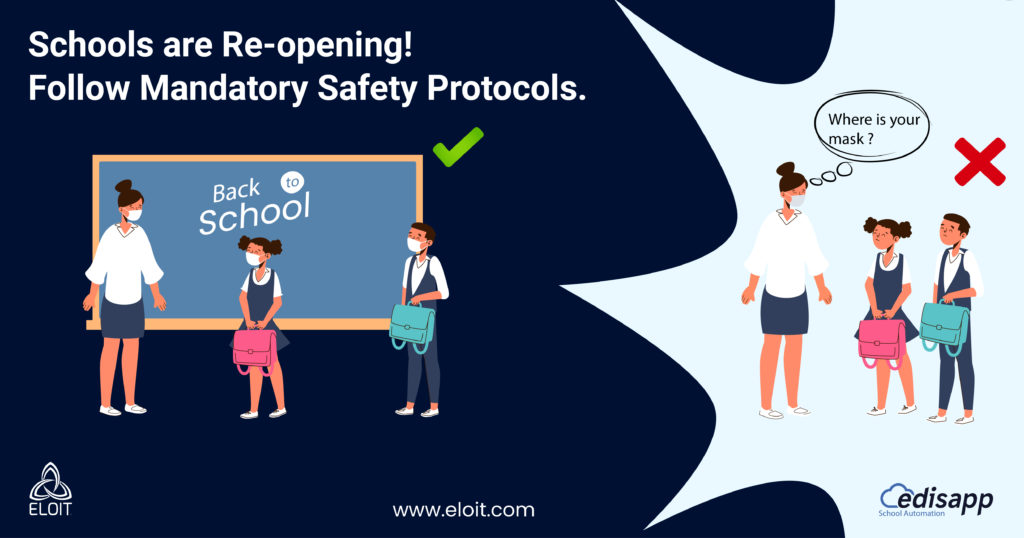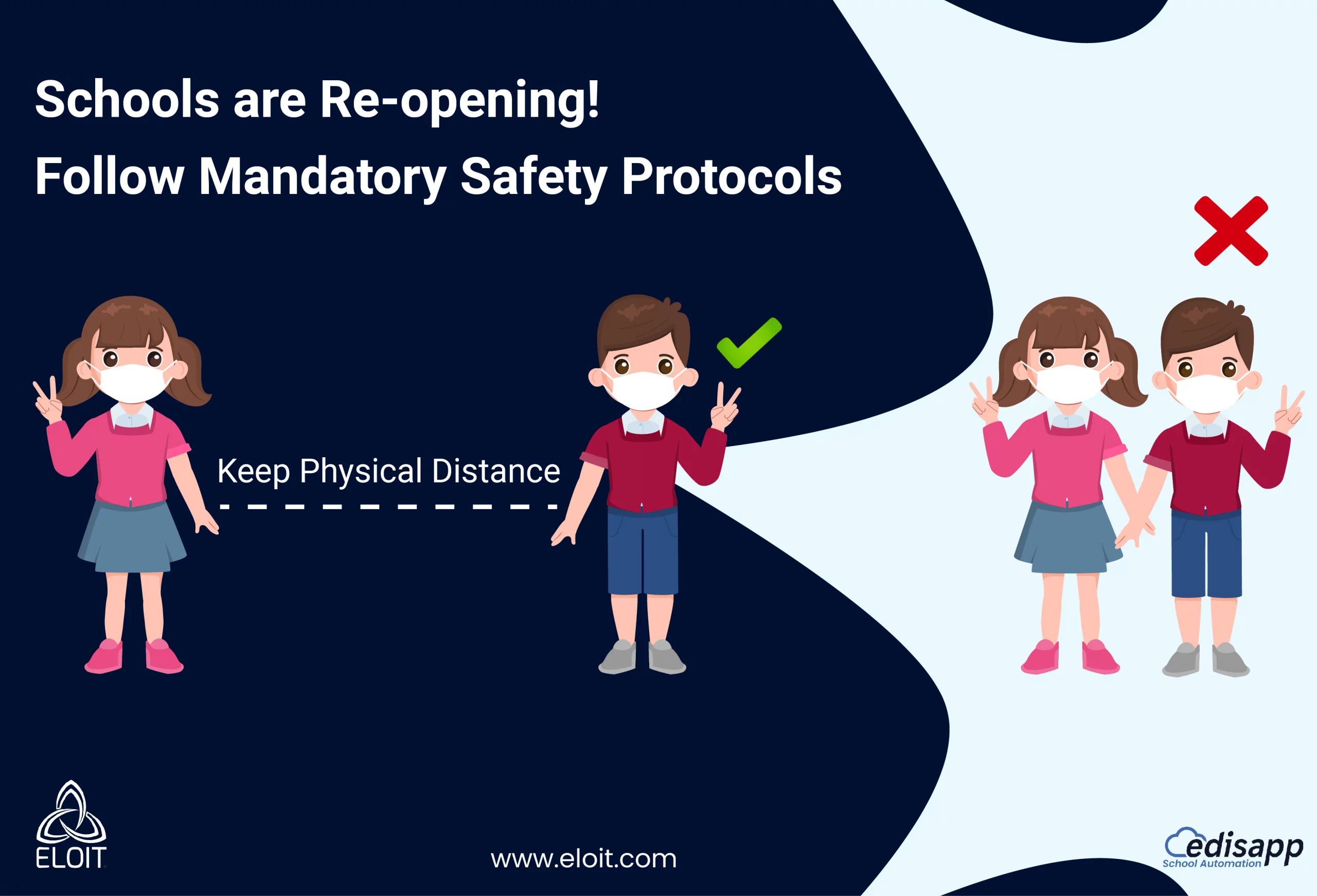Free Demo
A single most important lesson learned throughout the pandemic is teachers' critical role in ensuring that learning continues during and after this back to school phase. There are a number of safety protocols in schools for COVID-19 that are to be followed.
When schools reopen, teachers must ensure that children can learn in a safe, sanitary environment and regain lost knowledge and abilities. Keep your social distance at school. For physical separation, you must create classroom ground rules that meet your school's administrative processes and the protocols specified by your country's government health authority.
Safety Protocols to keep in mind When you are Back to School include:
- Maintain a distance of a minimum of two meters between everybody present at school.
- Provide individual tables and chairs to all students and keep them at a distance from each other.
- Limit the possibility of mixing of students from different classes during and after school activities.
- Avoid crowded school pick-ups and drop-offs, and avoid having elderly family or community members pick up children.
Some children may be returning to school after hearing incorrect information about COVID-19 in their homes. You, as a teacher and management, would have to make them understand the reality and follow safety protocols.
Some critical steps in developing classroom rules and practices.
- Students must grasp what it is to obey the regulations.
- Respond to their worries and ideas by listening to them and answering their inquiries in an age-appropriate manner.
- Talk about the many reaction’s kids could have and explain that these are typical reactions to an abnormal circumstance.
To keep schools open, teachers must be protected against COVID-19 transmission in the community. As a result, once frontline health professionals and high-risk populations have been vaccinated, teachers should be the first to get vaccinated against COVID-19. COVID-19 vaccines are safe and effective techniques for preventing serious illness and mortality from COVID-19, even if they should not be necessary for school reopening and in-person learning. Some safety protocols to be followed are:
- Educators must safeguard themselves and others from COVID-19, and they must lead by example.
- Teachers should remind students to wash their hands or use hand sanitizers at entry and exit points, common book usage, and more.
- When coughing or sneezing, students should constantly cough or sneeze into their elbow. However, if they do so by accident in/on their hands, tell them to wash their hands or use hand sanitizer quickly. If children sneeze or cough into a tissue, make sure they throw it away right away and wash their hands. It is critical to normalize the concept of regular and routine handwashing.
- Instructing kids to avoid touching their eyes, nose, and mouth even if their hands are clean. Germs from such locations can transfer to their clean hands and spread around the classroom in this manner.
- Encourage frequent handwashing and sanitation, as well as the purchase of necessary materials. Set up and maintain a handwashing station.

Mask use that is consistent and accurate
When safety protocols in schools for COVID-19 are laid out then it is mandatory for students, staff and even visitors to follow them. All instructors, staff, and students must wear masks regularly and appropriately, they safeguard themselves and others. Teachers must ensure that children follow the guidelines regarding wearing a mask. Teachers must be vigilant when students are in busy places.
Indoors: Regardless of vaccination status, the Government Health Authority recommends indoor masks as a safety protocol for all persons aged three years and older, including students, instructors, employees, and guests.
Outdoors: The Public does not need to wear masks when they are outside in general. Wearing a mask is mandatory for those who are not vaccinated. This is applicable even when they are in close contact with other people as per the directions of The Ministry of Health.
Mask recommendations:
NIOSH Workplace Performance and Workplace Performance Plus masks are recommended.
Transportation to and from school: The MoH Order covers all modes of public transport, including school buses. Regardless of immunisation status, passengers and drivers must follow the safety protocol of wearing masks inside school buses, including those run by public and private school systems.
Schools should offer masks to pupils who require them, such as those who have forgotten theirs or whose families cannot afford them. There should be no disciplinary punishment imposed against a pupil who does not wear a mask.
Air circulation
There is a reason as to why safety protocols in schools for COVID-19 have to be implemented and followed strictly. Another important point is about improving air circulation which is a critical COVID-19 deterrent strategy that can help to minimize the number of germs in the air. Bringing fresh outdoor air into a facility, along with additional precautions such as wearing a well-fitting, multi-layered mask, helps keep particles from concentrating inside. Open numerous doors and windows, use child-safe fans to improve the efficacy of open windows, and make modifications to the HVAC or air filtering systems can all help.
If it is not a safety hazard, open windows on buses and other modes of transportation while travelling. Air circulation is improved by keeping windows open a few inches.
Recess time and Meals
- Masks have to be worn by staff at all times throughout meal preparation and serving, as well as during breaks, apart from when drinking or eating. Students should wear masks whenever they are not eating or drinking.
- Increase physical distance as much as possible by using extra locations outside of the canteen, such as the gymnasium or outdoor seats during recess for eating food. Students should not be restricted from in-person learning to meet a minimum distance requirement, especially during eating meals.
- Keep regularly touched areas clean. Before and after meals, all surfaces that come into touch with food should be disinfected and cleansed.
- Encourage washing hands beforehand, after, and during duties, before and even after eating, using the restroom and handling garbage, unwashed dishes, or removing gloves.
- Increase ventilation in places where food is prepared, served, and designated areas for eating.
Cleansing and Disinfection
Surfaces and things that are often handled, such as desks, worktops, doorknobs, computer keyboards, hands-on learning items, taps, phones, and toys, should be cleaned and disinfected daily.
Surfaces and items that are filthy should be cleaned right away. If surfaces or items have been stained with bodily fluids or blood, wear gloves and other customary measures to avoid contact with the fluid.
Guidelines to use cleaning supplies
- Make certain that you comprehend all instruction labels and that you understand safe and proper use.
- Follow the directions on the labels.
- Gloves and eye protection are frequently required while using cleaning chemicals and disinfectants. When dealing with bleach solutions, for example, gloves should be worn at all times to protect your hands.
- Do not combine disinfectants and cleaning products unless the labels say it's okay.
- Certain product combinations (like chlorine bleach and ammonia cleaners) might cause severe harm or death.
- Read the label to verify if the bleach is meant for disinfection. Check to see whether the product has not yet passed its expiration date. Certain bleaches, like those indicated for use on multi-coloured garments or for whitening, might not even be effective for disinfection.
- When adequately diluted, household bleach is helpful against coronaviruses.
- One must allow the solution to sit on the surface for at least 1 minute.
Procedures in case one of your students appear to be sick
Detecting COVID-19 indications
Fever, coughs, and exhaustion is the most prevalent symptoms. In addition, breathlessness, chest discomfort or pressure, muscle or body cramps, headache, loss of taste or smell, disorientation, sore throat, congestion or runny nose, diarrhoea, nausea and vomiting, stomach pain, and skin rashes are all possible symptoms.
Preparations in case if a student shows any of the symptoms
- Assign a particular area in the school (for example, near the entrance) as a waiting room for youngsters. The room must be well-ventilated. It is advised that school nurses be appointed personnel in this waiting area if they are available. If children become unwell or display COVID-19 symptoms, they should report to the appropriate room and wait until their parents or guardians pick them up. Each space should then be cleansed, sterilized, and sanitized. Provide the sick student with a medical mask if available
- Adopt regular screening for core temperature and a history of fever or feeling unwell in the past 24 hours for all employees, students, and visitors upon admission into the facility to detect ill people.
- Establish a mechanism for isolating unwell kids and staff from those who are well – without generating stigma – as well as a strategy for alerting parents and working with health care wherever possible.
- There's been multiple cases of children developing a multisystem inflammatory illness that may be related to COVID-19. Suppose you observe a rash, high blood pressure, or acute gastrointestinal issues in your students. In that case, this might be an indicator that they are suffering from multisystem inflammatory syndrome and should seek medical assistance at once.


